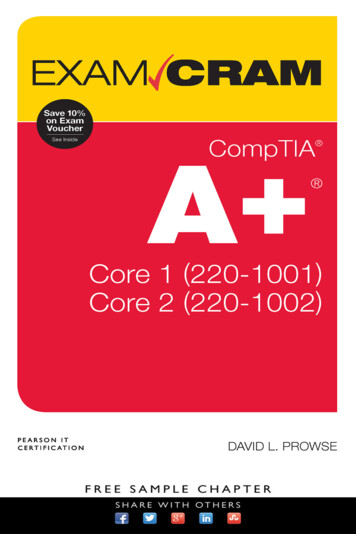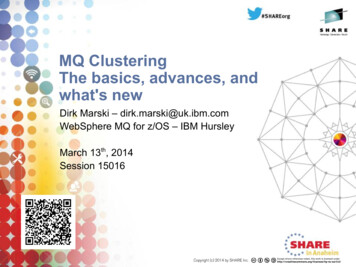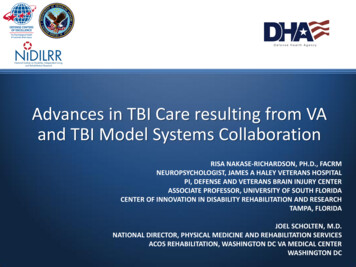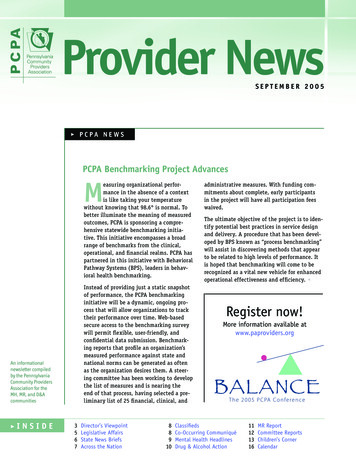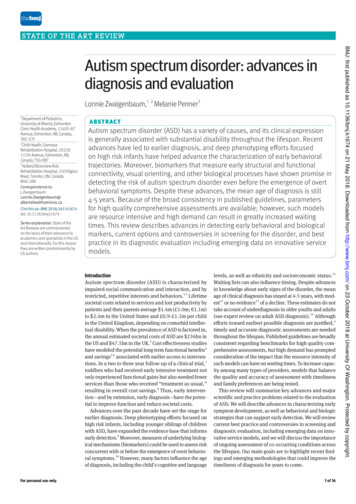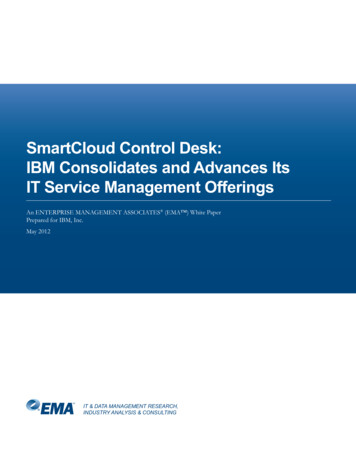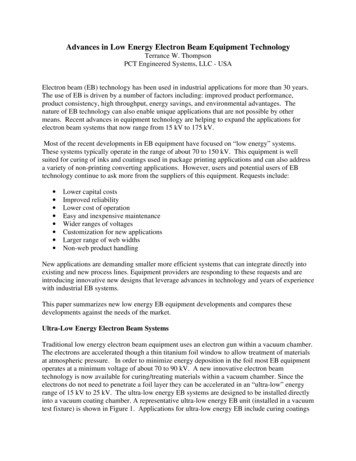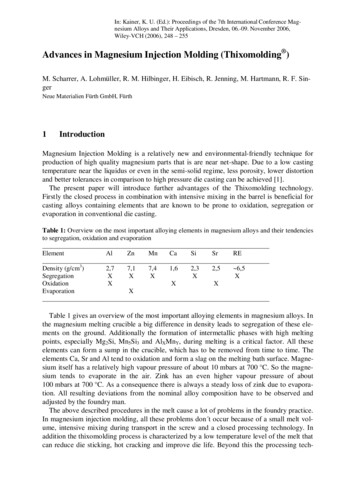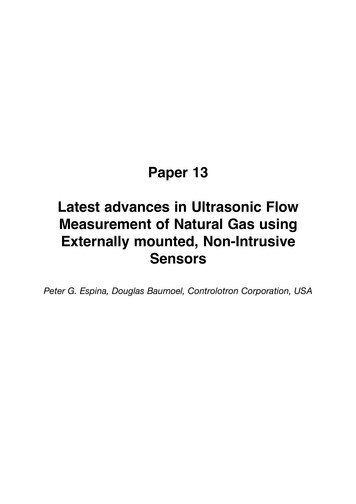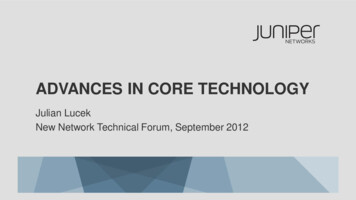
Transcription
ADVANCES IN CORE TECHNOLOGYJulian LucekNew Network Technical Forum, September 2012
LEGAL STATEMENTThis statement of product direction sets forth Juniper Networks’current intention and is subject to change at any time withoutnotice. No purchases are contingent upon Juniper Networksdelivering any feature or functionality depicted in thispresentation.2Copyright 2012 Juniper Networks, Inc.www.juniper.net
AGENDACore trends - and associated requirementsPTX - design philosophy and architectureOptical Integration into routersAdvances in multichassis technology3Copyright 2012 Juniper Networks, Inc.www.juniper.net
INFRATDM CircuitSwitching(SONET/SDH or OTN)Copyright 2012 Juniper Networks, tPacket Switching (MPLS)DWDMFibre4IP VPNsVoIPEthernet, ATM,FR PWsTVInfrastructurePrivateCircuits, ATM,Frame RelayMobile voiceSERVICESPOTS (64kcircuits)Migration to Packet-based Services
MIGRATION FROM ELECTRONIC CIRCUIT SWITCHING TOELECTRONIC PACKET SWITCHING1Electronic packet switching andelectronic circuit switching areconverging to similar cost0.90.8Relativeproportion0.7Packet-switched traffic But packet switching is much more0.6flexible0.5 Network traffic now comes from0.4computers or computer-like machines(PCs, web-servers, mobile devices,games consoles) and they naturallygenerate packets.0.30.2Circuit-switched traffic0.1 Even when a customer buys a circuit0time5Copyright 2012 Juniper Networks, Inc.service, they are often running packetsover it!www.juniper.net
REQUIREMENTS FOR THE MPLS CORENeeded:IPv4, IPv6, MPLS forwardingHighest possible capacityHigh-speed Ethernet ports only (10GE, 40GE, 100GE)IP MulticastMPLS Multicast (P2MP LSPs)Not needed:Full internet routing table in FIBEdge services (VPLS, L3VPN, Subs Mgmt.)6Copyright 2012 Juniper Networks, Inc.www.juniper.net
SYSTEM CAPACITY AS FUNCTION OF TIMEStreamlined corerouterSystemthroughput(log scale)General purposecore/edge routertime7Copyright 2012 Juniper Networks, Inc.www.juniper.net
PTX5000: SHIPPING SINCE MARCH 2012PTX 5000 17.6’’ (19’’ rack) x 33’’x62, (WxDxH)Port counts (line-rate, full-duplex) Max power consumption: 11kW 10GE: 384 Typical power consumption: 6.2kW 40GE: 32 8 line card slots, 2 PICs per slot 100GE: 32 Highest capacity in the entire industry Junos operating system Very low latency: 7 microseconds for 512 byte packet on 10GE link Record low Energy Consumption Ratio (ECR) of 1.54 Gbps/W8Copyright 2012 Juniper Networks, Inc.www.juniper.net
PTX FPC & FABRIC OVERVIEWPFE based on next generation of Juniper’ssilicon technology120 Gbps PFEcomplex 4 PFE complexes per LCSIB0Fabric chip resides on the SIB.FPC and SIBs connected orthogonally on themid plane9 SIBs in both the 8 slot and 16 slot chassis.Single stage fabric for both 8 and 16 slotsingle chassis PTXSIB8All 9 SIBs are active. PFEs spray across all 9SIBs Only 8 SIBs needed to sustain line ratetraffic. The 9th SIB being active all the time allowsfor fast SIB failover since all SIB to PFElinks are active.9Copyright 2012 Juniper Networks, Inc.FPCLookup chipQueuing chipwww.juniper.net
PTX KEY FUNCTIONALITY IGP protocols, including TE extensions: ISIS, OSPF MPLS protocols:oo LSP protection schemesooo10RSVP TE, LDPLSP Hierarchy: LDP over RSVP, RSVP over RSVP, Labelled BGP (RFC3107)Primary/Secondary RSVP LSPRSVP Fast-Reroute (1:1 protection, link protection, node protection).FRR for 50000 LSPs takes less than 20ms.IP Fast Reroute (Loop-Free Alternates) for OSPF, ISIS ( LDP)Copyright 2012 Juniper Networks, Inc.www.juniper.net
PTX KEY FUNCTIONALITY MPLS Multicast:oRSVP P2MP, LDP P2MP IP Multicast: PIM BGP (but not full internet table in FIB) Route Reflector support for all BGP address families Seamless MPLS Border Node; Interprovider Option B and C11Copyright 2012 Juniper Networks, Inc.www.juniper.net
PTX KEY FUNCTIONALITY BFD, including BFD over MPLS LSPs LSP ping and traceroute Ethernet OAM (802.1ag and 802.3ah) PE for Point-to-point pseudowires: LDP signalling (L2circuit), BGPsignalling (L2VPN) 12VCCV and VCCV-BFDFirewall Filters and Policers Including Two-Rate Tricolour Marking, Single-Rate Tricolour markingECMP over 64 pathsLAG with 64 child linksSynchronous EthernetCopyright 2012 Juniper Networks, Inc.www.juniper.net
QUEUEING AND SCHEDULINGScheduling BA and MF Classifiers Port based queuing - 8 queues per port Four levels of scheduling priorityoStrict-highoHighoMediumoLow Four drop priorities per queue Full delay-bandwidth buffering on all ports (100 ms)13Copyright 2012 Juniper Networks, Inc.www.juniper.net
4588862726656704074247808819285768960Throughput (%)THROUGHPUT CHART (IPV4)100901480706050403020100Packet size (bytes)Copyright 2012 Juniper Networks, Inc.www.juniper.net
28691272967680806484488832Throughput (%)THROUGHPUT CHART (IPV6)100901580706050403020100Packet size (bytes)Copyright 2012 Juniper Networks, Inc.www.juniper.net
4588862726656704074247808819285768960Throughput (%)THROUGHPUT CHART (MPLS)100901680706050403020100Packet size (bytes)Copyright 2012 Juniper Networks, Inc.www.juniper.net
PTX CUSTOMER ANNOUNCEMENTSLondon Internet Exchange (LINX) -01.html s/Wednesday/Cobb.pdf http://www.youtube.com/watch?v F8WrVakhPwI&featuVerizon on/2012/verizon-to-deploy-the.html “Verizon plans to deploy the Juniper Networks PTX Series in majormarkets in the U.S. and Europe by the end of this year, giving thecompany the densest multiprotocol label switching platform availablein the industry, with an initial capacity of eight terabits per second”17Copyright 2012 Juniper Networks, Inc.www.juniper.net
TREND: CONSOLIDATION OF PACKET NETWORKSSome operators have ended up having multiple packet networks fordifferent purposes, for example: Separate Public IP and Private IP networks Or separate Business and Residential networks Or separate L3 networks and L2 networksHowever, this is inefficient for both CAPEX and OPEX reasons, andreduces one of the key benefits of packet networks: efficient bandwidthutilisation through packet aggregation, statistical multiplexing.Hence there is now a strong trend to consolidate these separatenetworks.18Copyright 2012 Juniper Networks, Inc.www.juniper.net
TREND: CONSOLIDATION OF THE PACKET NETWORKS (CONT’D)Also the traffic patterns are complementary: Business Services (e.g. L3VPN, Layer 2 services) peak duringthe day Residential peaks during the eveningPacket schedulers/queues give segregation betweendifferent services, while still allowing them to use eachother’s spare bandwidth, on a millisecond by millisecondbasis19Copyright 2012 Juniper Networks, Inc.www.juniper.net
Separate packet networks for different routerP-routerPEPEWasteful duplication of resources, some opportunity for bandwidth sharing is missed!20Copyright 2012 Juniper Networks, Inc.www.juniper.net
Common core, separate PEs for different servicesresidentialbusinessPEPECommon core network –benefit from more uterPEPESuch merger project is already in progress, using PTX as the P-router21Copyright 2012 Juniper Networks, Inc.www.juniper.net
Common core, common PEs (MultiService Edge)All servicesAll servicesPEPEP-routerP-routerPE22PECopyright 2012 Juniper Networks, Inc.www.juniper.net
SOME PTX FAQS1/ Can PTX be used as a Route Reflector (RR)?Yes, PTX has full Junos control plane functionality. Uses the same REas the TX Matrix Plus SFC. This RE can hold millions of prefixes in theRIB. Can act as RR for all BGP address families, even ones that arenot supported in the FIB (e.g. BGP-VPLS).2/ Can PTX forward IP packets, as well as MPLS packets?Yes, at wire-speed! Note that the FIB currently supports 48k longestmatching IP prefixes, so not the full internet table.23Copyright 2012 Juniper Networks, Inc.www.juniper.net
OPTICAL INTEGRATION
OPTIMUM CORE ARCHITECTUREOnly one network layer needed–thepacket layerCore routers interconnected by DWDMpoint-to-point linksProtection based on IP/MPLS schemesThis architecture has been used for manyyears in many networks, and works verywellLet’s see how the way the router isconnected to the DWDM system can beimproved.25Copyright 2012 Juniper Networks, Inc.www.juniper.net
Grey interfaces versus Coloured interfacesCFP grey opticsRouterLong-haul coloured opticsCFP grey opticsTransponderon DWDMsystemTransponderon DWDMsystemRouterRouterRouterNo transponder on DWDM system!Coloured, tunable 100 GE interface on the router.26Copyright 2012 Juniper Networks, Inc.www.juniper.net
INTEGRATION SIMPLIFICATION: ANALOGIES FROM THE PAST1/ In the early days, when connecting arouter to a PDH link, needed an externalCSU/DSU.vLater, the CSU/DSU function was built intothe router port, eliminating the need for aseparate CSU/DSU unit.2/ Early dial-up modems were separateunits. Later, these were integrated ontovPCI cards and later still onto PCmotherboards.27Copyright 2012 Juniper Networks, Inc.www.juniper.net
MONITORING THE PRE-FEC BERPre-FECPost-FECErroredbitsFECPre-FEC BER rate status: OK28Copyright 2012 Juniper Networks, Inc.www.juniper.net
MONITORING THE PRE-FEC BER (CONT’D)Pre-FECPost-FECErroredbitsFECPre-FEC BER rate status: signal degrade. Link down and FRR triggered before packets are lost.29Copyright 2012 Juniper Networks, Inc.www.juniper.net
COHERENT DETECTION001001 Very resilient tochromatic dispersion (CD)and polarisation modedispersion (PMD)! Removes need for in-lineCD and PMDcompensators11 Good spectral efficiency(2 bps/Hz)Above diagram is for one polarisation. Using the orthogonal polarisation in addition,carry 4 bits per symbol in total (DP-QPSK)30Copyright 2012 Juniper Networks, Inc.www.juniper.net
Traditional DWDM system (e.g. as deployed for N x 10G/40G)AmpCDAmpcomp.CDAmpcomp. In-line compensators for Chromatic Dispersion (CD) – analogue optical devices System is labour-intensive to design and turn-up (“hand-crafted”) Undesirable dependencies between line-system characteristics and transmitter/receiver characteristics onoverall system performanceDWDM system with coherent detection electronic post-processing(as being deployed for N x 100G)AmpAmpAmp No in-line compensators needed – compensation/signal processing all happens fully automatically inthe electronic domain (DSP on ASIC) at the receivers Much more “plug-and-play” in nature31Copyright 2012 Juniper Networks, Inc.www.juniper.net
BEFORE COHERENTOpticalPerformanceVendor WVendor XVendor YVendor Z“Optical Performance” e.g. maximum distance.Before coherent, optical performance parameters were a competitive benchmarkbetween vendors.32Copyright 2012 Juniper Networks, Inc.www.juniper.net
WITH COHERENTOpticalPerformanceVendor WVendor XVendor YVendor ZNo performance difference between different vendors: deterministicdigital processing replaces highly-tuned analogue processing33Copyright 2012 Juniper Networks, Inc.www.juniper.net
OTS-1000 DWDM SYSTEMComplements coloured 100G interfaces on router Supports 96 wavelengths @ 100G System reach of 2500kmFlexible bandwidth allocation for future modulationformatsHigh performance optical amplification Integrated hybrid EDFA Raman for various fiber types Extended C band support Low noise figure & high flatness No dispersion compensation module needed34Copyright 2012 Juniper Networks, Inc.www.juniper.net
BLACK LINK SCHEMATIC35Copyright 2012 Juniper Networks, Inc.www.juniper.net
ITU-T: BLACK LINKSBlack Links initiative in ITU-T G.698.2 (11/2009) “Common equipment” (multiplexers, amplifiers, ROADMs etc) from one vendor Sources and receivers from other vendor(s), for example on routersAssociated management framework/MIBs being defined in org/html/draft-galikunze-ccamp-g-698-2-snmp-mib-00 MIB contains source and receiver characteristics, alarms and PM informationWe will follow this approach Coloured interfaces on router connected to OTS-1000 Coloured interfaces on router connected to another vendor’s DWDM system36Copyright 2012 Juniper Networks, Inc.www.juniper.net
VIRTUAL TRANSPONDER MODEL USING BLACK 00GRouterDWDMMUXDWDM LINKDWDMMUXRouterJuniper or 3rd Party Line SystemBlack Links MIB allows routers to expose Performance Monitoringinformation and Alarms to the NMS.37Copyright 2012 Juniper Networks, Inc.www.juniper.net
ADVANCES INMULTICHASSISTECHNOLOGY
MULTICHASSIS TECHNOLOGYT1600T4000TXPSFCT1600T4000We are pioneers inmultichassis technology,since the TX Matrix in2004.2011 was a record yearfor multichassis T-seriesshipments.T1600T400039T1600T4000Copyright 2012 Juniper Networks, Inc.20% of deployed T-serieschassis are part of amultichassis system.www.juniper.net
WHY MULTICHASSISNon- multichassis capable platform System capacity is challenged to keepMultichassis Capacitypace with traffic growth(Single Chassis) Though the systems might support ahigher capacity with new linecards/fabric upgrade, slots may not beavailable to do the sameBandwidth Create periods of uncertainty Forces early adoption of higher capacityline cards Forced upgrade of line cards – reducesthe lifespan of line cardsCopyright 2012 Juniper Networks, Inc.Requirementvs. capacitygapTime Increases CAPEX over a period time40Systemcapacitygrowthwww.juniper.netSlots filled
SOME FACTS ABOUT MULTICHASSISFrom the day-to-day operational point of view, not very different to asingle chassis The system is a single node from the routing protocol point of view Central “brain” (the RE in the central chassis) Single point of management Single config file, just like for a standalone chassis Seamless slot numbering in config (e.g. “slot 10” rather than“chassis 2, slot 3”) When using link aggregation (LAG), member links can be ondifferent chassis41Copyright 2012 Juniper Networks, Inc.www.juniper.net
MULTICHASSIS TECHNOLOGYNext version of T-SeriesMultichassis is about to beta(Q4 4000Copyright 2012 Juniper Networks, Inc. 4 x T4000 Or 8 x T1600 Or a mixture of T4000 andT1600We will also have multichassisPTX in future.www.juniper.net
MULTICHASSIS INTERCONNECTSIn all of our multichassis systems, the interconnectsbetween the chassis are optical Not possible to have electrical interconnects at thesehigh data rates over tens of metres But people have found optical interconnections to beinconvenient, because of having to clean/inspect largenumbers of optical connectors at installation time Is there a way of having optical cables, but with thezero-maintenance attributes of an electrical cable?43Copyright 2012 Juniper Networks, Inc.www.juniper.net
MULTICHASSIS INTERCONNECTCXP optical module is permanentlysealed onto the optical cable in thefactory.CXP Active Optical CableNo dust or grease can get onto theoptics.As easy as plugging in an EthernetCAT5 cable.40 cables between each T4000 LCCand the SFC.Note: we will also supply separate CXP modules and cables if preferred to AOC.44Copyright 2012 Juniper Networks, Inc.www.juniper.net
CXP INTERCONNECTEach CXP cable consists of 24 “lanes” (fibres), 12 in each direction.We have per-lane power monitoring/reporting.Spare lane not needed for data used to carry an internal identifier, inorder to detect mis-cablingOptional mode to make it easier to plug cables into correct sockets onLCC and SFC. Red LEDs flash on first pair of ports to be connected. When they are connected, the LEDs stop flashing. The LEDs from the nextpair of ports start flashing and so on.45Copyright 2012 Juniper Networks, Inc.www.juniper.net
SUMMARYAdvent of PTX: streamlined router for the core. Highest capacity in the industry Junos Operating System - extensive protocol and feature supportOptical Integration commoditisation of optical transmission Integration of long-haul transponders into the router.Next generation of multichassis technology46Copyright 2012 Juniper Networks, Inc.www.juniper.net
“Verizon plans to deploy the Juniper Networks PTX Series in major markets in the U.S. and Europe by the end of this year, giving the company the densest multiprotocol label switching platform available in the industr
